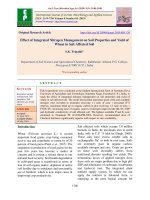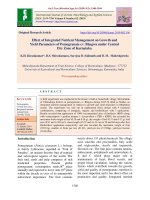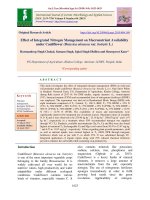Effect of integrated nitrogen management on yield and economics of foxtail millet genotypes
Bạn đang xem bản rút gọn của tài liệu. Xem và tải ngay bản đầy đủ của tài liệu tại đây (339.71 KB, 4 trang )
Int.J.Curr.Microbiol.App.Sci (2019) 8(8): 2543-2546
International Journal of Current Microbiology and Applied Sciences
ISSN: 2319-7706 Volume 8 Number 08 (2019)
Journal homepage:
Original Research Article
/>
Effect of Integrated Nitrogen Management on Yield and
Economics of Foxtail Millet Genotypes
B. Selectstar Marwein, Rajesh Singh* and Punnam Chhetri
Naini Agricultural Institute, SHUATS, Prayagraj-211007, India
*Corresponding author:
ABSTRACT
Keywords
Foxtail millet,
Integrated nitrogen
management, Yield
and Economics
Article Info
Accepted:
22 July 2019
Available Online:
10 August 2019
A field experiment was conducted during the kharif season of 2018 on Foxtail millet of
varieties SIA 3156 and SIA 326 (PRASAD) at Crop Research Farm, Department of
Agronomy, Naini Agricultural Institute, SHUATS, Prayagraj (U.P). the experiment was
laid out in Randomized Block Design with 6 treatments combinations, consisting of two
varieties of Foxtail millet (SIA 3156, SIA 326) and nitrogen management viz., Farmer’s
practice (NPK= 40:20:0), 100% RDF (NPK= 50:30:20)), 75% RD N + 25% N through
PM, 75% RD N + 25% N through PM + Azospirillum SI, 50% RD N + 50% N through
PM and 50% RD N + 50% N through PM + Azospirillum SI. The Experiment revealed
that in variety SIA 3156, integration of inorganic fertilizer of 75% RD N through Urea +
25% N through PM + Azospirillum Seed Inoculation resulted in maximum grain yield
(2.31 t /ha), higher Net return (₹ 32,229.35 /ha) and maximum B:C ratio (2.59). In variety
SIA 326, the experiment reveals that 75% RD N through Urea+ 25% N through Poultry
Manure found out to be the best treatment which result in highest grain yield (2.31 t /ha),
highest Net return (₹ 25,946.09 /ha) and B:C ratio (2.28).
Introduction
Foxtail millet (Setaria italica L. Beauv) is
important minor millet belonging to the
family Poaceae. In India, the cultivation of
foxtail millet is confined to Andhra Pradesh,
Karnataka, and Tamil Nadu. It's grain used for
human consumption and a feed for poultry
and cage birds. It is used in several food
preparations like chapati, fermented bread,
biscuits, malts, etc. the stalks are used as
fodder and for thatching. It is rich in
micronutrients and good for diabetic patients.
It protects against cancer and related heart
diseases (Anon., 1993). Foxtail millet comes
under drought tolerant crop and it can be
grown as a short-term catch crop. It is adapted
to a wide range of elevation, soils, and
temperatures. It is usually grown in the
marginal lands having low level of nutrients
and organic matter. However, it responses to
the amount of fertilizers used and they
significantly contribute in yield and yield
attributing characters. Fertilizer management
is one of the important cost-effective factors
known to augment the crop production. The
supplementation of fertilizers along with the
organic manure plays the key role in overall
2543
Int.J.Curr.Microbiol.App.Sci (2019) 8(8): 2543-2546
balance supply of nutrients owing to the better
growth and production of the crop. The
potential of foxtail millet as rainfed crop has
not been fully exploited.
Materials and Methods
The experiment was carried out during Kharif
season 2018 at Crop Research Farm,
Department of Agronomy, Naini Agricultural
Institute, Sam Higginbottom Institute of
Agriculture, Technology and Sciences,
Prayagraj (U.P.), which is located at 25o40’94”
N latitude and 81085’35” E longitude of 98
meter above the sea level (MSL). This area is
situated on the right side of the river Yamuna
by the side of Allahabad Rewa Road about 5
km away from Allahabad city. The soil of
experimental field was sandy loam, pH of soil
was 7.3 with 0.690% organic C, having
available N, P, K, 278.75, 18.2 and 250.5 kg
h-1 respectively. The experiment involving
two varieties of Foxtail millet SIA 3156 and
SIA 326 (Prasad) which was laid out in
randomized block design with six treatments
replicated thrice, comprising Farmer’s
practice (NPK= 40:20:0), 100% RDF (NPK=
50:30:20)), 75% RD N + 25% N through PM,
75% RD N + 25% N through PM +
Azospirillum SI, 50% RD N + 50% N through
PM and 50% RD N + 50% N through PM +
Azospirillum SI.
Results and Discussion
Effect on yield of foxtail millet
The data on yield as influenced by Integrated
Nitrogen Management on two varieties of
Foxtail millet are presented in Table 1. In
variety SIA 3156, the treatment A14 (75%
RDN through urea + 25% N through Poultry
Manure + Azospirillum SI) was recorded with
highest grain yield (2.31 t /ha). However, A16
(50% RD N through urea + 50% N through
Poultry Manure + Azospirillum SI) and
treatment A13 (75% RD N through urea + 25%
N through Poultry Manure) were statistically
at par with treatment A14 (75% RD N through
urea + 25% N through Poultry Manure +
Azospirillum SI). With regard to straw yield
and harvest index, there was no significant.
However treatment A12 (RDF (NPK=
50:30:20) was recorded with maximum straw
yield (3.87 t/ha). Integration of inorganics,
organics and bio-fertilizer might have exerted
a pronounced effect on yield of Foxtail millet.
Poultry manure has also significant effect on
grain yield of foxtail millet as reported by
Damar et al., 2016. In respect of Azospirillum
inoculated treatments, a well-developed root
system coupled with increased availability of
nutrients could have promoted greater uptake
of nutrients resulting in higher grain yield
(Rana, 1985).
In variety SIA 326, a significant grain yield
(1.78 t/ha) was recorded with treatment A23
(75% RD N through urea + 25% N through
Poultry Manure). There were no significant
with regard to straw yield. However,
treatment A23 (75% RD N through urea + 25%
N through Poultry Manure) was recorded with
maximum straw yield (5.33 t/ha). The
conjunctive use of organic and inorganic
sources has beneficial effect on physiological
process of plant metabolism and growth
thereby leading to higher grain yield and
straw. The easy availability of nitrogen due to
mineralization of organics influences the
shoot and root growth favouring absorption of
other nutrients. Similar results were obtained
by Varalakshmi et al., (2005), Yakadri and
Reddy (2009), Umesh et al., (2006) and
Basavaraju and Purushotham (2009).
Effect on economics of Foxtail millet
In variety SIA 3156, treatment A14 (75% RD
N through urea + 25% N through Poultry
Manure + Azospirillum SI) was recorded with
highest Gross return (₹ 52,526.66 /ha), Net
2544
Int.J.Curr.Microbiol.App.Sci (2019) 8(8): 2543-2546
return (₹ 32,229.35 /ha) and B:C ratio (2.59).
While treatment A11 [Farmer’s practice
(NPK= 40:20:0)] was recorded with lowest
Gross return (₹ 41,733.26 /ha) and treatment
A16 (50% RD N through urea + 50% N
through Poultry Manure + Azospirillum SI)
was recorded with lowest Net return (₹
22,777.89 /ha) and B:C ratio (2.01).
Table.1 Effect of Integrated Nitrogen Management on yield of Foxtail millet
Varieties
SIA 3156
SIA 326 (PRASAD)
Fertilizer Treatment
Farmer’s practice (NPK= 40:20:0)
RDF (NPK= 50:30:20)
75% RD N + 25% N through PM
75% RD N + 25% N through PM + Azospirillum SI
50% RD N + 50% N through PM
50% RD N + 50% N through PM + Azospirillum SI
S.E.(m)±
CD (P = 0.05)
Grain Yield
(t/ha)
1.73
1.81
2.09
2.31
1.95
2.15
0.10
0.31
Straw Yield
(t/ha)
3.53
3.87
3.27
3.16
3.13
3.59
0.62
-
Grain Yield
(t/ha)
1.28
1.46
1.78
1.37
1.23
1.37
0.09
0.30
Straw Yield
(t/ha)
4.74
4.12
5.33
5.20
4.08
4.30
0.82
-
Table.2 Effect of Integrated Nitrogen Management on Economics of Foxtail millet
Varieties
SIA 3156
Fertilizer Treatment
SIA 326 (PRASAD)
Net
return
(₹ /ha)
24,556.76
B:C
ratio
Farmer’s practice (NPK= 40:20:0)
Gross
return
(₹ /ha)
41,733.26
2.42
Gross
return
(₹ /ha)
33,873.34
Net
return
(₹ /ha)
16,696.84
RDF (NPK= 50:30:20)
43,866.74
75% RD N + 25% N through PM
25,847.84
2.43
35,699.94
17,681.04
1.98
48,333.34
28,086.03
2.39
46,193.40
25,946.09
2.28
75% RD N + 25% N through PM +
Azospirillum SI
50% RD N + 50% N through PM
52,526.66
32,229.35
2.59
39,673.26
19,375.95
1.95
45,253.34
22,777.89
2.01
32,700.06
10,224.61
1.42
50% RD N + 50% N through PM +
Azospirillum SI
48,773.34
26,247.89
2.16
36,006.66
13,481.21
1.60
In variety SIA 326, Treatment A23 (75% RD
N through urea + 25% N through Poultry
Manure) was recorded with highest Gross
return (₹ 46,193.40 /ha), Net return (₹
25,946.09 /ha) and B:C ratio (2.28). While
treatment A25 (50% RD N through urea + 50%
N through Poultry Manure) treatment was
recorded with lowest Gross return (₹
32,700.06 /ha), Net return (₹ 10,224.61 /ha)
B:C
ratio
1.97
and B:C ratio (1.42). Ramdev et al., (2017)
reported that integration of Poultry manure
with RDF result in higher net return in Pearl
millet which is close conformity as reported
by Singh et al., (2013) under two years
studies on pearl millet.
In variety SIA 3156, on the basis of the above
finding it can be concluded for obtaining
2545
Int.J.Curr.Microbiol.App.Sci (2019) 8(8): 2543-2546
higher grain yield (2.31 t /ha), higher Net
return (₹ 32,229.35 /ha) and maximum B:C
ratio (2.59), treatment A14 (75% RD N + 25%
N through Poultry Manure + Azospirillum SI)
was found to be the best treatment from all
other treatments. And in variety SIA 326, it
can be concluded for obtaining higher grain
yield (2.31 t /ha), higher Net return (₹
25,946.09 /ha) and B:C ratio (2.28), treatment
A23 (75% RD N + 25% N through Poultry
Manure) was found to be the best treatment
from all other treatments.
References
Bhuva, H. M., and Sharma, S. (2015).
Influence of nutrient uptake by
irrigation, nitrogen and phosphorus and
their effect on quality parameter of rabi
pearl millet. Journal of Progressive
Agriculture, 6(1), 134-137
Damar, W.K.,Garba, A., Russom, Z., Ibrahim,
S. A., Haggai, P.T. and Dikwahal, H.D.
2016. Effect of Poultry Manure on
Growth and Yield of Finger Millet
(Eleusine Coracana L. Gaertn) In The
Northern Guinea Savannah, Nigeria.
PAT June,; 12 (1): 173-18.
Devegowda G. 1997. Poultry manure excreta
and other wastes as a source organic
manures. In: training course on organic
farming, UAS, Gkvk, Bangalore, 7-11.
Gruhn, P., Goletti, F. and Yudelman, M.
2000. Integrated nutrient management,
soil fertility and sustainable agriculture:
current issues and future challenges.
IFRPI 2020 Vision Brief.
Intodia.S.K. 1994. Response of foxtail
millet(Setaria italica) genotypes to
levels of nitrogen and phosphorus under
rainfed condition. Indian Journal of
Agricultural Sciences 64(12): 861-862.
Liu Y, Ding YF, Wang QS, Meng DX, Wang
SH. 2011. Effects of nitrogen and 6benzylaminopurine on rice tiller bud
growth and changes in endogenous
hormones and nitrogen. Crop Science
51:786–792.
Naik, B., Linge Gowda, T.B.K., Thimme
Gowda, S and Sridhara, S. 1995. Effect
of integrated nutrient management on
growth and grain yield of foxtail millet
(Setaria italica L. Beauv.) under rainfed
conditions on Alfisols of sub tropical
India. Fertilizer News. 40(3): 55-57.
Naik, T.B., Murthy, R.K and Pushpa, K.
2010. Effect of integrated nutrient
management on growth and yield
parameters of foxtail millet (Setaria
italica) under rainfed condition of
alfisols. Environment and Ecology.
28(2): 762-765.
Pallavi, Ch., Joseph, B., Aarif Khan,M.A. and
Hemalatha,S. 2016. Effect of integrated
nutrient management on nutrient
uptake, soil available nutrients and
productivity of rainfed fingermillet.
International Journal of Science,
Environment
and
Technology.
5(5):2798-2813
Rana BS. Efficent management of dry land
crops. CRIDA, Hyderabad. 1985; pp.
43.
Shashidhara, G.B and Basavarajappa, R.
1997. Response of little millet
genotypes to different doses of NPK
fertilizers. Karnataka Journal of
Agricultural Sciences. 11(2): 344-346.
How to cite this article:
Selectstar Marwein, B., Rajesh Singh and Punnam Chhetri. 2019. Effect of Integrated Nitrogen
Management
on
Yield
and
Economics
of
Foxtail
Millet
Genotypes.
Int.J.Curr.Microbiol.App.Sci. 8(08): 2543-2546. doi: />
2546









